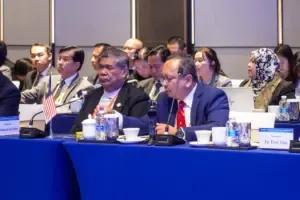Melaka Water Regulatory Body targets 13,000 forest trees at Durian Tunggal and Jus dams to restore biodiversity and support climate initiatives
JASIN: The Melaka Water Regulatory Body (BKSA) aims to plant approximately 13,000 forest trees at the state’s two main dams through a phased restoration programme.
BKSA director Azizul Adzran Mahmor said the programme rehabilitates degraded areas while restoring biodiversity balance.
He announced that 3,920 trees were successfully planted at Durian Tunggal Dam in the second phase following an earlier 5,000 trees at Jus Dam.
“We are confident of achieving the target of another 5,000 trees at the Jus Dam within three years,” Azizul Adzran told reporters.
He explained that selected tree species use less water while supporting long-term ecosystem restoration.
The director spoke at the Jus Dam Phase II Restoration Forest Tree Planting Programme ‘Green Our Dam’, officiated by Melaka Financial Officer Datuk Salhah Salleh.
Azizul Adzran noted that 400 trees were planted in today’s programme as part of ongoing conservation efforts.
The programme involves collaboration between Global Environment Centre and Sahabat Mesra Alam Rimba Terpelihara.
Species planted include Merawan Siput Jantan, Kasai Daun Besar, and Keruing Neram trees identified as ecologically suitable.
The planting area was a former oil palm site no longer permitted for cultivation.
Restoration occurs systematically through continuous maintenance by SMART partners.
First-phase results at Durian Tunggal Dam show positive development as forest vegetation matures.
Wildlife including birds, deer, and wild boars have returned to their original habitats.
“If a camera is installed, we can see for ourselves the presence of fauna, which proves this area is recovering,” he said.
The programme supports BKSA’s long-term environmental sustainability commitment.
It aligns with the Malaysia Greening Initiative through the 100 Million Tree-Planting Campaign.
The restoration also contributes to global efforts addressing climate change.
“This restoration programme not only helps increase carbon dioxide absorption, but also restores important habitats for local wildlife,” Azizul Adzran added.
The initiative strengthens ecosystems for the benefit of local communities around the dams. – Bernama
Post Views: 1






